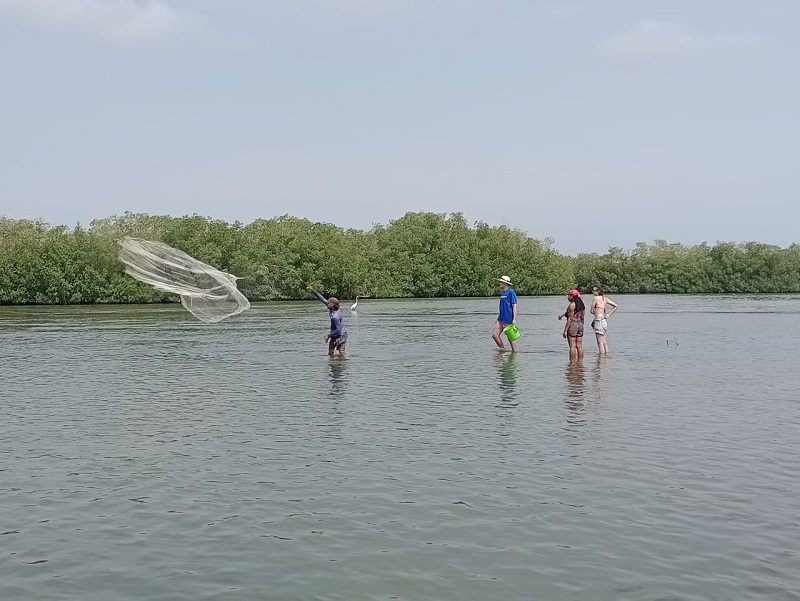Written by Karen Garcia-Ramos, (Pomona College), Student Correspondent for CET Colombia, Spring 2024
With the semester coming to a close, it was time for us to embark on our long-awaited Traveling Seminar. This week-long trip to Colombia’s Caribbean coast comes included in the program as an extension of our core class, Race and Identity: Debates in the Colombian Context. Additionally, this trip is intentionally scheduled during the program’s latter end to allow for Spanish levels to improve, along with our cumulative knowledge of self-governed Afro-descendent communities in Colombia, called consejos comunitarios.
Though folks in the program had been taking trips around the country independently from the study abroad program, the traveling seminar was the perfect opportunity to spend time as a collective while furthering our understanding of how the Afro-Colombian experience varies by region.
San Basilio de Palenque
We landed in Cartagena de Indias on Sunday afternoon, a famous tourist destination renowned for its colorful colonial architecture, rich history, and beautiful beaches. Before beginning our time in Cartagena, however, we took a bus from the airport to San Basilio de Palenque where we would spend the following two days.
Known more commonly as Palenque, this consejo comunitario is recognized as the first liberated town in the Americas. It was originally a Maroon community, meaning its original members were escaped enslaved people who acquired their freedom through resistance and revolts. Founded in 1713 by revolt leader Benkos Bioho, Palenque, as it operates today, has deep perceptible roots to the population’s direct African lineage.


(Left) This was one of the many murals we saw on our walking tour of San Basilio de Palenque. It reads “San Basilio de Palenque: Territory Free of Gender-based Violence”. (Right) This mural features keywords in Palenquero, the Spanish-based creole spoken in San Basilio de Palenque; Palenquero is influenced strongly by Bantu languages and has impressively survived centuries of colonial violence. For example, jarocho (located in the bottom right corner) means happiness.
We had homestay accommodations in Palenque, currently the only housing option available for tourists. Four other CET students and I stayed with Señora Gabriela and Señor Andres in their home. We ate breakfast and dinner daily, played cards with Gabriela, and were entertained by their stories and chickens!
Outside of the homestay, we engaged in numerous workshops with the Palenquero community, such as traditional medicine, drumming and dance, a conversation about and with women in Palenque, and an ancestral justice presentation with members of the Guardia Cimarrona, or Maroon Guards. Additionally, we had a traditional lunch at a local farm where we shared a Colombian soup called sancocho, one of my favorite experiences from the Traveling Seminar.

Cartagena
After two days in San Basilio, we said goodbye to our host families and took a bus to our hostel in Cartagena, where we would stay for the remainder of the week. The day we arrived, we took a tour of the city which included stops at a convent called La Popa, the San Felipe de Barajas fortress, a walkthrough of the city’s “old town,” and concluding in the Getsemaní neighborhood, where we were staying.
The following day, we were invited to a school in the Nelson Mandela neighborhood located just outside Cartagena. The students, with the support of teachers and staff, prepared a program for our visit, including introductions, traditional dance performances, questions for us about our experience in Colombia thus far, and space for us to share a popular dance from the U.S. with them to truly embody the exchange component.


La Boquilla
The most memorable day for me was on Thursday when we spent the entire day at La Boquilla, located slightly further up the coast north of Cartagena. We began the day with tours of the mangroves by boat, led by local fishermen. Each boat had a total of four people—three CET students plus the guide—which later turned into our fishing teams!
Once we reached a clearing in the water, we hopped off the boats and watched as our guide demonstrated how to cast the fishing net to catch sardines. We watched carefully as our guide cut the fish in half, which we used as bait in our crab traps. After setting the traps in the water, we returned to the clearing. It was our turn to cast the fishing net. Though seemingly intuitive, casting this net far and wide requires a great amount of strength and technique. Admittedly, we did not catch many sardines, but we ended up with a bucket full of crabs! Once back ashore, tired and hungry, we enjoyed a delicious seafood lunch featuring the crabs we caught.
The rest of the day was spent at the beach at La Boquilla, and we returned to our hostel around 6 pm. Overall, this week of experiential learning was as educational as it was entertaining. The time away from Cali, moreover, put a lot into perspective—most prominently, how intentional I want to be with my remaining time in Colombia.


Source link
All Materials on this website/blog are only for Learning & Educational purposes. It is strictly recommended to buy the products from the original owner/publisher of these products. Our intention is not to infringe any copyright policy. If you are the copyright holder of any of the content uploaded on this site and don’t want it to be here. Instead of taking any other action, please contact us. Your complaint would be honored, and the highlighted content will be removed instantly.

